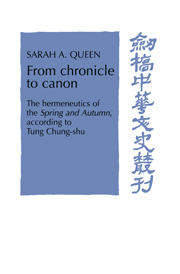Book contents
- Frontmatter
- Contents
- List of tables
- Acknowledgments
- List of abbreviations
- 1 Introduction
- PART I Three perspectives on the authenticity of the Ch'un-ch'iu fan-lu
- 2 A biography of Tung Chung-shu
- 3 A history of Tung Chung-shu's literary corpus
- 4 The authorship of the Ch'un-ch'iu fan-lu
- PART II Exegesis and canonization
- Appendix 1 The birth and death dates of Tung Chung-shu
- Appendix 2 The dates of the Han-shu 56 memorials
- Appendix 3 Han transmission of Kung-yang learning
- Appendix 4 Han dynasty disciples of Tung Chung-shu
- Appendix 5 Citations and titles attributed to Tung Chung-shu
- Appendix 6 Transmission of Ch'un-ch'iu fan-lu editions
- Selected bibliography
- Index
4 - The authorship of the Ch'un-ch'iu fan-lu
Published online by Cambridge University Press: 10 December 2009
- Frontmatter
- Contents
- List of tables
- Acknowledgments
- List of abbreviations
- 1 Introduction
- PART I Three perspectives on the authenticity of the Ch'un-ch'iu fan-lu
- 2 A biography of Tung Chung-shu
- 3 A history of Tung Chung-shu's literary corpus
- 4 The authorship of the Ch'un-ch'iu fan-lu
- PART II Exegesis and canonization
- Appendix 1 The birth and death dates of Tung Chung-shu
- Appendix 2 The dates of the Han-shu 56 memorials
- Appendix 3 Han transmission of Kung-yang learning
- Appendix 4 Han dynasty disciples of Tung Chung-shu
- Appendix 5 Citations and titles attributed to Tung Chung-shu
- Appendix 6 Transmission of Ch'un-ch'iu fan-lu editions
- Selected bibliography
- Index
Summary
Beyond Tung Chung-shu's biography and the history of his literary corpus examined in the first two chapters, internal characteristics of the Ch'un-ch'iu fan-lu also shed light on the text's authorship. Vocabulary, grammar, rhetorical style, literary form, viewpoint, and organization illuminate both the editing process that brought this work into existence and the materials that were employed to compile it. This chapter provides a preliminary analysis of these features in conjunction with the last two chapters, to further my argument that the Ch'un-ch'iu fan-lu is a composite work, assembled by an anonymous compiler. The term ‘composite’ highlights two important aspects of the text. It contains essays authored by Tung Chung-shu and records of his doctrinal expositions addressed to different audiences in a number of diverse venues. Yet it also preserves heterogeneous writings, with a more complex and sometimes problematic relationship to the historical Tung Chung-shu. We will see, for example, that the authentic compositions provide a retrospective view of Tung's thought as it evolved throughout his long political career. Those authored by his disciples document developments in the Kung-yang tradition through the Eastern Han dynasty, while the rebuttals of his critics highlight the contested areas of Han discourse. In short, there is much to be gleaned from this problematic text.
Yet the techniques available to study early Chinese texts sometimes yield ambivalent results and the criteria to analyze these writings are highly contested.
- Type
- Chapter
- Information
- From Chronicle to CanonThe Hermeneutics of the Spring and Autumn according to Tung Chung-shu, pp. 69 - 112Publisher: Cambridge University PressPrint publication year: 1996
- 1
- Cited by



